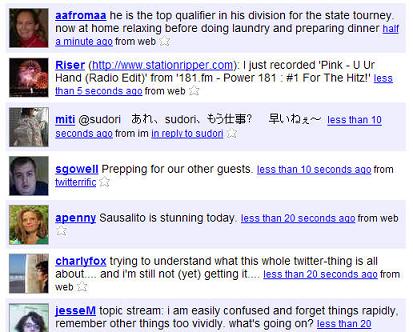It’s been called a micro-blogging platform, an electronic water cooler and a wonderful way to keep tabs on friends and family. It’s Twitter, and all I wanted to know is: Is this something marketers should be tracking? Here’s my answer.
Yes.
You should track Twitter. But do it on your own terms. Or simply keep tabs on someone who is on the Twitter network. This concept will definitely morph, but it is not going away.
As promised in the footnote to my dismissive blog entry about this technology, I will recount my 14 days in Twitterland. For those who need a grounding in what Twitter is, I suggest you click on the link above. It loads in a new browser window, so you won’t lose your place. Are you back? Okay, let’s do this thing.
The first thing I discovered was that the people who would never, ever get a blog, or comment on other people’s blogs, have willingly signed up for Twitter. They have eagerly posted their 140 characters of news, weather and sports. I joke, but these posts do often resemble what contemporary television news has devolved into: The most superficial look at important headlines, plus trivia and human interest. And in saying that, I do not mean to disparage, because, like local news, this is very addictive.
Especially when you’re a friend or relative of the fellow “newscasters.”
When you’re part of this micro-blogosphere, all other activity you’re engaged in at that moment comes to a brief halt while you check your computer screen, IM window, or cell phone text messages to learn such tidbits as: “Man, that soup was hot. It scalded my mouth!” I’m making this one up, but it’s the type of flotsam and jetsam that comes drifting your way when you dip your oar in the vast Twitter Ocean.
Below is a sample I grabbed just now from the Twitter Public Timeline, a real-time stock ticker of global “Tweets” from those willing to share their tidbits with the world.

Again, I must assure you that I am not dismissing this type of information exchange. Just as the real definition of flotsam and jetsam is “potentially valuable goods jettisoned from a ship,” there are many gems that are shared with the friends, family and co-workers that one lets into one’s network. These gems slide into view suddenly and quietly, along with the detritus. It’s all disposable, but at the same time riveting.
In my 14 days on a small Twitter network (less than 10 participants), I’ve learned things. Oh, yes. I’ve learned quite a bit.
I’ve been sent links to interesting sites and videos. I’ve gotten to know more about distant friends’ lives. I’ve even discovered that I’ve missed an important appointment. And none of this was in my email box, which is crammed enough as it is. This is good on a micro level. And this is potentially important on a macro level.
I suspect that when the next Twin Towers catastrophe occurs, those on a Twitter network will get important and potentially life-saving alerts (“A plane just hit the second tower!”). Remember: On 9/11/01, when the voice lines of cell phones were jammed and inaccessible, and the electricity was off, the last goodbyes were sent to loved ones via cell phone SMS text messages. Grimly, this form of communication was still available, for brief, real-time expressions of fear, resignation and undying love.
If my suggestion of Twitter having that kind of utility shocks you, I must say it shocked me too. But it is also something that follows a clear path. Anthropologist Danah Boyd stated recently that initial web sites — we’ll call them Web 1.0 — were about ideas. With web sites and simple emails, people who didn’t know each other before became acquainted around shared interests and passions. Web 2.0 is all about people. Since the web has become ubiquitous (at least with the majority of the young, and 100% of the world’s information workers), you could keep connected with nearly everyone you know, and even have them broker introductions to those you don’t know (the magic of MySpace and Facebook “friends” and LinkedIn “connections”).
So what is the coming Web 3.0 about? Place.
Or, more importantly, place and time. Who is where I am right now? Other systems like Dodgeball hinted at this promise of a real-world / virtual network. Twitter expands on that promise. It is about place in a big way.
If you want to spend some mindless computer time, check out this Google mash-up of the Twitter public timeline. That will remind you of how quickly this world is shrinking … and help to demonstrate the global, and univeral, appeal of Twitter.
Finally, I offer this challenge. I want to see if Twitter can help me get acquainted with some interesting, like-minded marketing types. So I’m going to do a little experiment: I’m posting my Twitter posts to the world for the next week, and see who might want to add me to their Twitter Friends list. Specifically, I want to know how many people I could get to know. Can I connect with individuals whose flotsam and jetsam would make for an interesting and instructive complement to the Tweets I’m receiving now? And can some real business conversations come of it?
I’ll let you know.
One Reply to “Twitter sends flotsam and jetsam our way. Marketers: Take notice!”
Comments are closed.